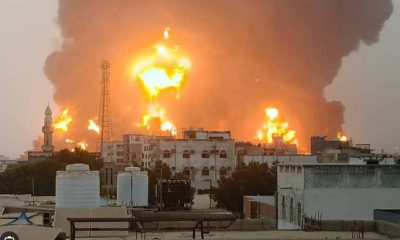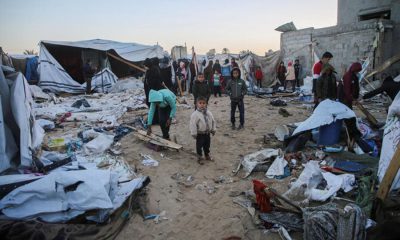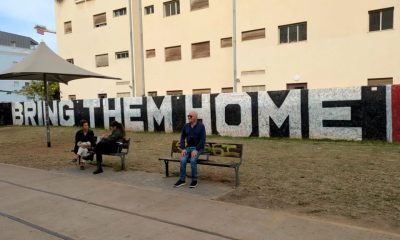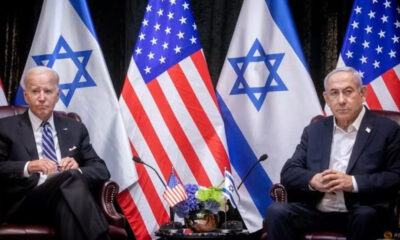International
Inside Israel’s combat zone in southern Lebanon
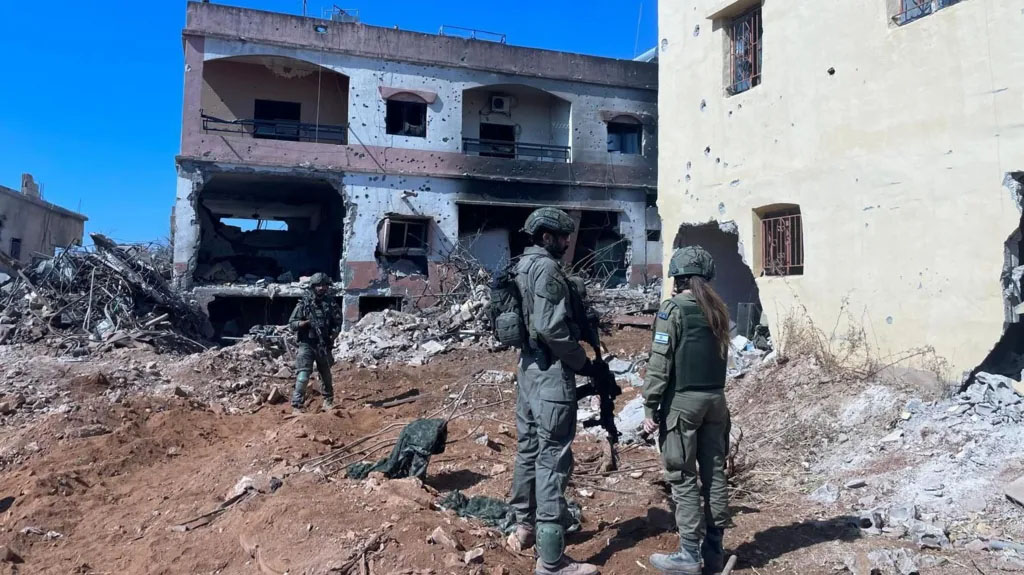
Inside Israel’s combat zone in southern Lebanon
Israeli army vehicles had already pounded the dirt road into dust where we crossed into Lebanon, breaking through a hole in the fence that marks the ceasefire line drawn between the two countries a generation ago.
The ceasefire itself is already in tatters.
Israel’s ground invasion along this border last week was launched, it said, to destroy Hezbollah weapons and infrastructure in “limited, localised, targeted raids”.
Ten days on, the army was taking us to a village a couple of miles into Lebanese territory, where it had just established “some level of control”.
We were told not to reveal where it is, for military reasons, and our movements were restricted.
Israeli artillery was blasting through the air as we arrived. The brigade commander, Col Yaniv Malka, told us the area was still not clear of Hezbollah fighters.
Bursts of small-arms fire were from fighting that was taking place 500m away, he said, describing “face-to-face combat” with Hezbollah fighters inside the village just a couple of days before – meaning, he said, “my troops seeing in their eyes, and fighting them in the streets”.
All along the central path through the village, houses lay demolished; piles of rubble leaching glimpses of family life. Buildings left standing were shot through with artillery, missing corners or walls and peppered with gunshot and shrapnel holes.
Two tanks sat in churned up earth near what was once a village square. The level of destruction around them is reminiscent of Gaza.
Our movements on the ground were restricted by the army to a limited area of the village, but neighbouring buildings and communities appeared, from a distance, to be untouched.
These incursions seem – so far – to be more “limited and targeted” geographically than militarily.
The graffiti on a building commandeered by troops read: “We wanted peace, you wanted war”.
READ ALSO:
- Ukrainian journalist, 27, who chronicled Russian occupation dies in prison
- Cleric predicts gang-up plot to unseat Senate President Akpabio
- Israeli strikes kill 29 people in Gaza, medics confirm
“Most of the terrorists ran away,” Col Malka told me. “[But] dozens of houses were booby-trapped. When we went house to house, we discovered booby-traps and weapons. We had no choice but to destroy them.”
We only have the army’s account of what happened here.
I asked an army spokesman whether any women or children were present when the operation here began. He replied that all civilians had been given ample warning to leave.
The human rights group Amnesty International this week described Israel’s evacuation warnings in southern Lebanon as inadequate and overly general, and said they did not absolve the country of its obligations under international law.
We were also shown three caches of weapons it said were found inside civilian homes here, including boxes of brand-new mortars, new anti-tank missiles and mines, as well as sophisticated shoulder launched rockets and night-scopes.
One anti-tank missile we saw was already semi-assembled.
The chief of staff for the 91st Division, Roy Russo, also showed us a garage he said had been used as an equipment warehouse, with sleeping bags, body armour, rifles and ammunition hidden in a large barrel.
“This is what we call an exchange zone,” he said. “They’re morphing from civilians into combatants. All this gear is designed to manoeuvre into [Israel] and conduct operations on the Israeli side. This is not defensive equipment.”
This, Israel says, is why it launched its invasion of southern Lebanon; that Hezbollah’s stockpiles of weapons and equipment along this border were planning for a cross-border attack similar to last year’s 7 October attacks by Hamas in southern Israel.
At the start of this invasion, the army revealed that Israeli special forces had been operating across the Lebanese border in small tactical units for almost a year, conducting more than 70 raids to find and destroy Hezbollah infrastructure, including underground tunnels – one of which, it said, stopped 30m (100ft) before the ceasefire line with Israel and was unfinished.
Col Malka showed me some of the weapons he said the army found on the day we arrived. They include a large IED, an anti-personnel mine, and a high-tech night-scope.
He said troops were finding “two to three times” the number of weapons they found in Gaza, with “thousands” of weapons and thousands of pieces of ammunition found in this village alone.
READ ALSO:
- Nigeria ranks 5th globally in food insecurity
- I will not challenge Edo election result – Olumide Akpata
- EFCC declares oil mogul Bolaji Akinduro wanted over fraud
“We don’t want to hold these places,” he told me. “We want to take all the ammunition and fighting equipment out. After that, we expect the people will come back, and understand that peace is better for them, and terrorist control over them in a bad thing.”
“But I’ll leave that to the diplomats to solve,” he smiled.
After the last ground war between Israel and Hezbollah in 2006, the UN ruled that Hezbollah must pull back north of the Litani River. A previous resolution also ordered its disarmament. Neither decision has been enforced.
That ground war in 2006 was a wake-up call for Israel. The Iran-backed militia fought its army to standstill. For almost 20 years, both sides have been avoiding – and preparing for – the next one.
Col Malka fought in Lebanon during that war. “This one is different,” he said.
When I asked why, he replied: “Because of 7th October.”
As we were speaking, the sound of small-arms fire grew louder. He gestured towards it. “That’s my guys fighting in the casbah,” he said.
Israel’s ground invasion is part of a dramatic escalation against Hezbollah over the past three weeks that has also seen it intensify air strikes on southern Lebanon and parts of Beirut.
Lebanon says more than 2,200 people have been killed, mainly during the recent escalation, and more than a million people displaced.
Hezbollah began firing rockets into northern Israel on 8 October last year, the day after Hamas’s deadly attack on southern Israel. The Iran-backed group says it is acting in solidarity with the Palestinians and has said it will stop firing if there is a ceasefire between Israel and Hamas in Gaza.
Israel accuses Hezbollah of using civilians as human shields. One commander described the ground war as an offensive operation to defend Israeli citizens – an invasion to stop an invasion, in other words.
But the speed with which Israel’s forces have been moving through villages along this border may only be the first chapter in this story.
Hezbollah tactics have shifted since the ground invasion began, with Israeli towns like Metula – surrounded on three sides by Lebanon – reporting a drop in direct fire from anti-tank missiles, and a rise in rockets fired out of sight from further away.
The assessment of many is that Hezbollah fighters have not run away, but simply withdrawn further back into Lebanon.
Israel already has four divisions lined up at this border – and a growing chorus of voices inside the country who say this is the moment, not just to push back Hezbollah, but to remake the Middle East.
As the fighting near the village intensified, we were told to leave immediately, hurried out to the waiting convoy.
Under the shadow of a growing conflict with Iran, Israel’s small successes along this frontier don’t change one key fact: this is not actually a border war, it’s a regional war being fought along a border.
Inside Israel’s combat zone in southern Lebanon
International
Syria not threat to world, rebel leader al-Sharaa tells BBC
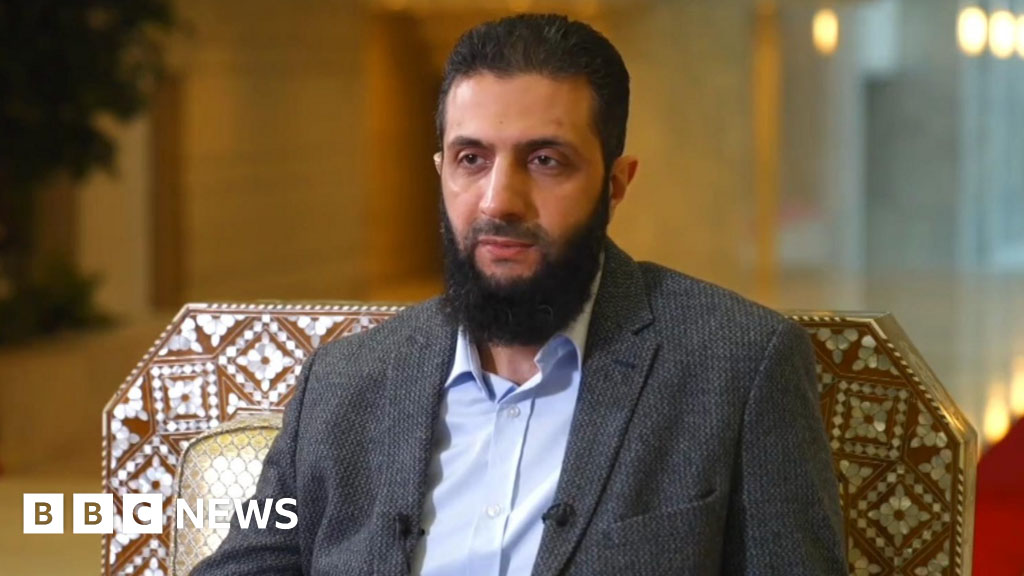
Syria not threat to world, rebel leader al-Sharaa tells BBC
The de facto leader of Syria, Ahmed al-Sharaa, has said the country is exhausted by war and is not a threat to its neighbours or to the West.
In an interview with the BBC in Damascus, he called for sanctions on Syria to be lifted.
“Now, after all that has happened, sanctions must be lifted because they were targeted at the old regime. The victim and the oppressor should not be treated in the same way,” he said.
Sharaa led the lightning offensive that toppled Bashar al-Assad’s regime less than two weeks ago. He is the leader of the Hayat Tahrir al-Sham (HTS), the dominant group in the rebel alliance, and was previously known by his nom de guerre of Abu Mohammed al-Jolani.
He said HTS should be de-listed as a terrorist organisation. It is designated as one by the UN, US, EU and UK, among many others, as it started as a splinter group of al-Qaeda, which it broke away from in 2016.
Sharaa said HTS was not a terrorist group.
They did not target civilians or civilian areas, he said. In fact, they considered themselves to be victim of the crimes of the Assad regime.
He denied that he wanted to turn Syria into a version of Afghanistan.
READ ALSO:
- Tinubu’s 2025 budget will increase poverty, worsen economy – PDP
- Real Madrid outclass Pachuca to win FIFA Intercontinental Cup
- Israel hits ports, energy sites in Yemen after missile intercepted
Sharaa said the countries were very different, with different traditions. Afghanistan was a tribal society. In Syria, he said, there was a different mindset.
He said he believed in education for women.
“We’ve had universities in Idlib for more than eight years,” Sharaa said, referring to Syria’s north-western province that has been held by rebels since 2011.
“I think the percentage of women in universities is more than 60%.”
And when asked whether the consumption of alcohol would be allowed, Sharaa said: “There are many things I just don’t have the right to talk about because they are legal issues.”
He added that there would be a “Syrian committee of legal experts to write a constitution. They will decide. And any ruler or president will have to follow the law”.
Sharaa was relaxed throughout the interview, wearing civilian clothes, and tried to offer reassurance to all those who believe his group has not broken with its extremist past.
Many Syrians do not believe him.
The actions of Syria’s new rulers in the next few months will indicate the kind of country they want Syria to be – and the way they want to rule it.
Syria not threat to world, rebel leader al-Sharaa tells BBC
BBC
International
Israel hits ports, energy sites in Yemen after missile intercepted
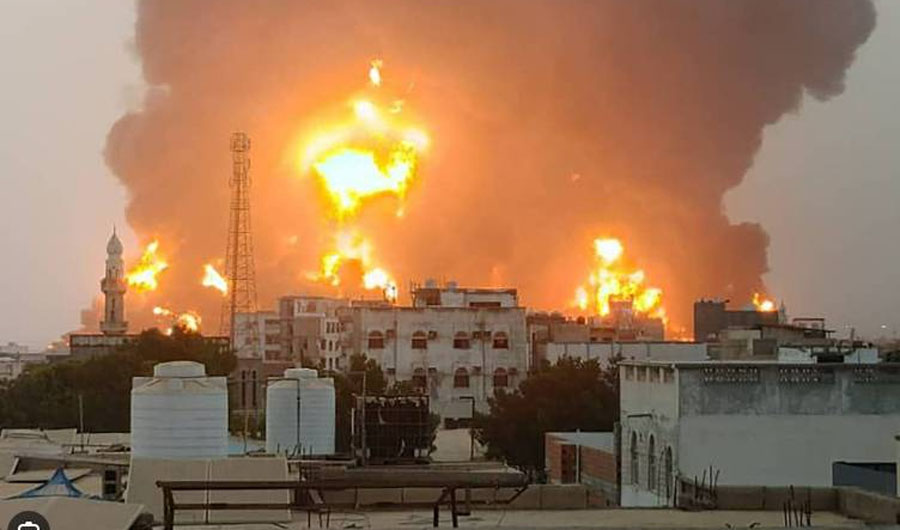
Israel hits ports, energy sites in Yemen after missile intercepted
JERUSALEM: Israel said Thursday it struck ports and energy infrastructure it alleges are used by Houthi militants, after intercepting a missile fired by the group.
Israel’s military said it “conducted precise strikes on Houthi military targets in Yemen — including ports and energy infrastructure in Sanaa, which the Houthis have been using in ways that effectively contributed to their military actions.”
The announcement came shortly after Israel said it had intercepted a missile fired from Yemen.
Al-Masira, a media channel belonging to the Houthis, said a series of “aggressive raids” were launched in the Yemeni capital of Sanaa and the port city of Hodeidah.
It reported raids that “targeted two central power plants” in Yemen’s capital Sanaa, while in Hodeidah it said “the enemy launched four aggressive raids targeting the port… and two raids targeting” an oil facility.
The strikes were the second time this week that Israel’s military has intercepted a missile from Yemen.
On Monday, the Houthis claimed a missile launch they said was aimed at “a military target of the Israeli enemy in the occupied area of Yaffa” — a reference to Israel’s Tel Aviv area.
READ ALSO:
- Gaza mediators intensify ceasefire efforts, Israeli strikes kill 20 people
- PDP expels South-East national vice chairperson over anti-party activities
- Your information on $1bn investment misleading, Dangote Refinery replies NNPCL
Also Monday, an Israeli navy missile boat intercepted a drone in the Mediterranean after it was launched from Yemen, the military said.
The Houthi militants have said they are acting in solidarity with Palestinians and pledged Monday to continue operations “until the aggression on Gaza stops and the siege is lifted.”
On December 9, a drone claimed by Houthis exploded on the top floor of a residential building in the central Israel city of Yavne, causing no casualties.
In July, a Houthi drone attack in Tel Aviv killed an Israeli civilian, prompting retaliatory strikes on the Yemeni port of Hodeidah.
The Houthis have also regularly targeted shipping in the Red Sea and the Gulf of Aden, leading to retaliatory strikes on Houthi targets by United States and sometimes British forces.
Israeli military spokesman Daniel Hagari said the group had become a “global threat,” pointing to Iran’s support for the militants.
“We will continue to act against anyone, anyone in the Middle East, that threatens the state of Israel,” he said.
Israel hits ports, energy sites in Yemen after missile intercepted
International
Gaza mediators intensify ceasefire efforts, Israeli strikes kill 20 people
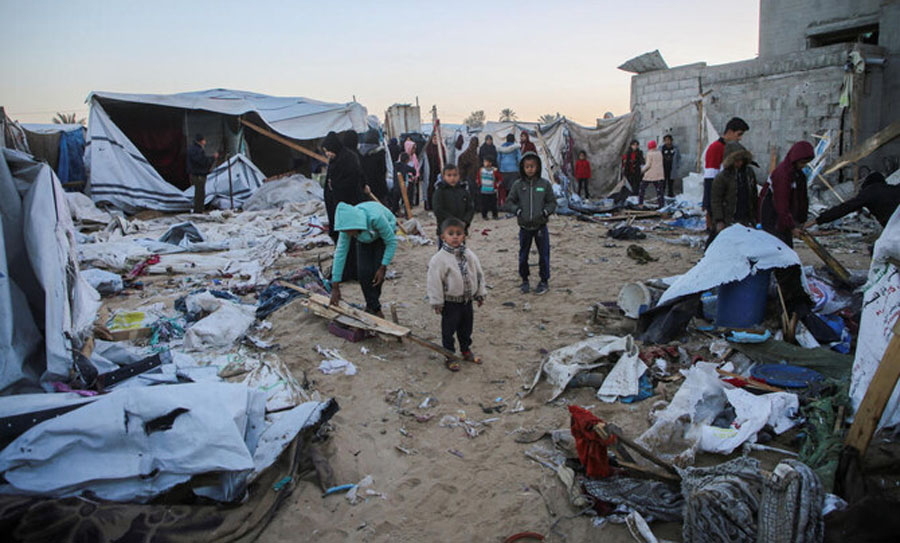
Gaza mediators intensify ceasefire efforts, Israeli strikes kill 20 people
CAIRO: The United States, joined by Arab mediators, sought on Wednesday to conclude an agreement between Israel and Hamas to halt the 14-month-old war in the Gaza Strip where medics said Israeli strikes killed at least 20 Palestinians overnight.
A Palestinian official close to the negotiations said on Wednesday that mediators had narrowed gaps on most of the agreement’s clauses. He said Israel had introduced conditions which Hamas rejected but would not elaborate.
On Tuesday, sources close to the talks in Cairo, the Egyptian capital, said an agreement could be signed in coming days on a ceasefire and a release of hostages held in Gaza in return for Palestinian prisoners held by Israel.
Medics said an Israeli airstrike killed at least 10 people in a house in the northern town of Beit Lahiya while six were killed in separate airstrikes in Gaza City, Nuseirat camp in central areas, and Rafah near the border with Egypt.
In Beit Hanoun in the northern Gaza Strip, medics said four people were killed in an airstrike on a house. There was no immediate comment from the Israeli military spokesman.
Israeli forces have operated in the towns of Beit Hanoun and Beit Lahiya as well as the nearby Jabalia camp since October, in a campaign the military said aimed to prevent Hamas militants from regrouping.
Palestinians accuse Israel of carrying out acts of “ethnic cleansing” to depopulate the northern edge of the enclave to create a buffer zone. Israel denies it.
READ ALSO:
- PDP expels South-East national vice chairperson over anti-party activities
- Your information on $1bn investment misleading, Dangote Refinery replies NNPCL
- Many die at Ibadan children’s Christmas party stampede, organisers arrested
Hamas does not disclose its casualties, and the Palestinian health ministry does not distinguish in its daily death toll between combatants and non-combatants.
On Wednesday, the Israeli military said it struck a number of Hamas militants planning an imminent attack against Israeli forces operating in Jabalia.
Later on Wednesday, Muhammad Saleh, director of Al-Awda Hospital in Jabalia, said Israeli shelling in the vicinity damaged the facility, wounding seven medics and one patient inside the hospital.
The Israeli military had no immediate comment.
In the Central Gaza camp of Bureij, Palestinian families began leaving some districts after the army posted new evacuation orders on X and in written and audio messages to mobile phones of some of the population there, citing new firing of rockets by Palestinian militants from the area.
CEASEFIRE GAINS MOMENTUM
The US administration, joined by mediators from Egypt and Qatar, has made intensive efforts in recent days to advance the talks before President Joe Biden leaves office next month.
In Jerusalem, Israeli President Isaac Herzog met Adam Boehler, US President-elect Donald Trump’s designated envoy for hostage affairs. Trump has threatened that “all hell is going to break out” if Hamas does not release its hostages by Jan. 20, the day Trump returns to the White House.
CIA Director William Burns was due in Doha on Wednesday for talks with Qatari Prime Minister Sheikh Mohammed bin Abdulrahman Al-Thani on bridging remaining gaps between Israel and Hamas, other knowledgeable sources said. The CIA declined to comment.
Israeli negotiators were in Doha on Monday looking to bridge gaps between Israel and Hamas on a deal Biden outlined in May.
There have been repeated rounds of talks over the past year, all of which have failed, with Israel insisting on retaining a military presence in Gaza and Hamas refusing to release hostages until the troops pulled out.
The war in Gaza, triggered by a Hamas-led attack on communities in southern Israel that killed some 1,200 people and saw more than 250 abducted as hostages, has sent shockwaves across the Middle East and left Israel isolated internationally.
Israel’s campaign has killed more than 45,000 Palestinians, displaced most of the 2.3 million population and reduced much of the coastal enclave to ruins.
Gaza mediators intensify ceasefire efforts, Israeli strikes kill 20 people
ARAB NEWS
-

 Railway16 hours ago
Railway16 hours agoLagos Rail Mass Transit part of FG free train ride – NRC
-

 metro2 days ago
metro2 days agoCourt stops customs from seizing imported rice in open market
-

 metro3 days ago
metro3 days agoFG transfers electricity market regulatory oversight in Lagos to LASERC
-
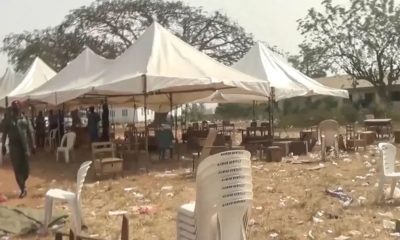
 metro2 days ago
metro2 days agoIbadan stampede: Tinubu orders probe as death toll hits 40
-
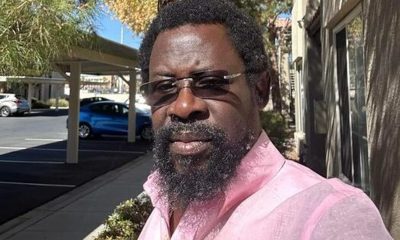
 metro2 days ago
metro2 days agoAfe Babalola: Court grants Dele Farotimi bail, barred from media interviews
-

 metro16 hours ago
metro16 hours agoNIMC warns against extortion, reaffirms free NIN enrollment
-

 metro1 day ago
metro1 day agoIbadan stampede: Ooni reacts after arrest of ex-wife
-

 News2 days ago
News2 days agoAdebayo Ogunlesi, 2 other Nigerians make Forbes 50 wealthiest Black Americans list 2024

